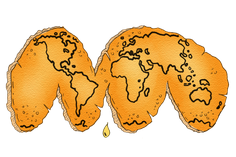Coordinate reference systems and 2D projections
A coordinate reference system provides information and parameters that ensure coordinates are correctly displayed on a map.
In general, the coordinate reference systems are divided into two groups:
Geographic coordinate reference System
When using a geographic coordinate reference system, the position is defined with angles, latitude (φ), and longitude (λ).
The origin of the angles is defined with the equator and a prime meridian. The units are degrees.
Geographic coordinate reference systems are widely used for the coordinate reference systems of image geolocation.
Some examples of geographic coordinate reference systems:
- WGS84 (EPSG:4326),
- NAD83 (EPSG:4269), and NAD83(2011) (EPSG:6318),
- ETRS89 (EPSG:4258).
Projected coordinate reference System
A projected coordinate reference system is a flat grid-based representation of the surface with coordinate references X and Y, or Easting and Northing.
Since the shape of the earth is typically represented by an oblate spheroid or ellipsoid, deformations are expected when projecting the coordinate references into 2D. By using the correct coordinate reference system, we try to limit the deformations.
Imagine the Earth like an orange (not a perfect shape). The orange must be peeled and unfolded to project the Earth on a plane and get a 2D projection of it.

When peeling the orange and laying the result on a table (projecting), there will be cracks and distortions. Different ways of projecting the orange will lead to different distortions at different places of the earth.

By choosing the coordinate reference system (datum and 2D projection), we try to ensure that:
- The distortions are locally minimized.
- The correct measurement unit is selected (meters, feet).
- The results are aligned with GIS data from other sources.

